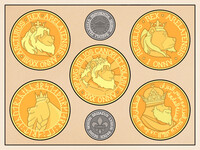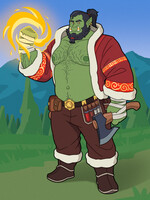
While I was doing research into D&D lore, the plasmoid race from Spelljammer caught my eye. This led me into a rabbit hole into the history of plasmoids in both 2e and 5e that left me conflicted about modern D&D, being somewhat disappointed at how it handles older editions' lore, and still finding some things from 5e Spelljammer pretty charming, including of course the plasmoids. I wanted to keep both versions in my personal 'canon'. Kind of an "eat your cake and have it too" situation. This is my attempt at reconciling the differences between the plasmoids in 2e and 5e.
The MC7 Monstrous Compendium Spelljammer Appendix for AD&D 2e introduced plasmoids with three subraces—DeGleash, DelNoric, and Ontalak. The DeGleash was agile and amorphous, capable of stretching over great distances and shaping its body away from attacking blows. The DelNoric could form a stiff, leathery hide to protect itself, though this hindered their shape-changing abilities. The Ontalak was an ambush predator that camouflaged itself as drifting spelljamming vessels to lure in its prey. A plasmoid could "hold its breath" for an hour, and was generally immune to piercing damage, poisons and disease, resistant to slashing damage, acid and cold, and vulnerable to heat, though these can vary for each subrace.
Then, after three decades, plasmoids were brought back into D&D 5e with Spelljammer: Adventures in Space, where they were also made into a playable race. They still retained their abilities to change their shape and hold their breath for an hour, but they are now only resistant to acid and poison. I have noticed, though, that there were still remnants of the old plasmoid subraces in the stat blocks in Boo's Astral Menagerie. The Plasmoid Warriors "can toughen their outer surfaces, giving themselves protection comparable to light armor", which is clearly reminiscent of the DelNoric plasmoids. The Plasmoid Boss has an increased size and Uncanny Dodge (a reaction that halves the damage it takes from an attack), which reminded me of the DeGleash plasmoid's ability to shape its form to dodge attacks.
So, the 5e plasmoids are generally smaller, weaker, and more limited in their abilities (the 2e plasmoids would have been too overpowered as playable races, after all). But, either as an adaptation to life in Wildspace or a random biological anomaly, a few lucky common plasmoids can unlock traits similar to their DeGleash and DelNoric cousins. With all that in mind, I decided to depict the 5e version as a "common" (I couldn't come up with a better name) variety of plasmoid, as seen here.
[2025/10/31]
The MC7 Monstrous Compendium Spelljammer Appendix for AD&D 2e introduced plasmoids with three subraces—DeGleash, DelNoric, and Ontalak. The DeGleash was agile and amorphous, capable of stretching over great distances and shaping its body away from attacking blows. The DelNoric could form a stiff, leathery hide to protect itself, though this hindered their shape-changing abilities. The Ontalak was an ambush predator that camouflaged itself as drifting spelljamming vessels to lure in its prey. A plasmoid could "hold its breath" for an hour, and was generally immune to piercing damage, poisons and disease, resistant to slashing damage, acid and cold, and vulnerable to heat, though these can vary for each subrace.
Then, after three decades, plasmoids were brought back into D&D 5e with Spelljammer: Adventures in Space, where they were also made into a playable race. They still retained their abilities to change their shape and hold their breath for an hour, but they are now only resistant to acid and poison. I have noticed, though, that there were still remnants of the old plasmoid subraces in the stat blocks in Boo's Astral Menagerie. The Plasmoid Warriors "can toughen their outer surfaces, giving themselves protection comparable to light armor", which is clearly reminiscent of the DelNoric plasmoids. The Plasmoid Boss has an increased size and Uncanny Dodge (a reaction that halves the damage it takes from an attack), which reminded me of the DeGleash plasmoid's ability to shape its form to dodge attacks.
So, the 5e plasmoids are generally smaller, weaker, and more limited in their abilities (the 2e plasmoids would have been too overpowered as playable races, after all). But, either as an adaptation to life in Wildspace or a random biological anomaly, a few lucky common plasmoids can unlock traits similar to their DeGleash and DelNoric cousins. With all that in mind, I decided to depict the 5e version as a "common" (I couldn't come up with a better name) variety of plasmoid, as seen here.
[2025/10/31]
Category Artwork (Digital) / Fantasy
Species Goo / Slime
Size 2080 x 1560px
File Size 3.83 MB

 FA+
FA+


![[Commission] Kutharx, Dragonkin Cleric/Rogue](http://t.furaffinity.net/59535295@200-1737001188.jpg)






Comments